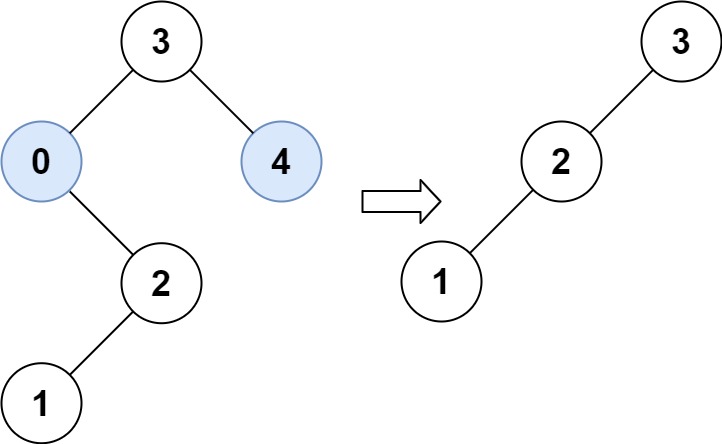2022-04-15 Daily-Challenge
Today I have done leetcode's April LeetCoding Challenge with cpp.
April LeetCoding Challenge 15
Description
Trim a Binary Search Tree
Given the root of a binary search tree and the lowest and highest boundaries as low and high, trim the tree so that all its elements lies in [low, high]. Trimming the tree should not change the relative structure of the elements that will remain in the tree (i.e., any node's descendant should remain a descendant). It can be proven that there is a unique answer.
Return the root of the trimmed binary search tree. Note that the root may change depending on the given bounds.
Example 1:

Input: root = [1,0,2], low = 1, high = 2
Output: [1,null,2]
Example 2:

Input: root = [3,0,4,null,2,null,null,1], low = 1, high = 3
Output: [3,2,null,1]
Constraints:
- The number of nodes in the tree in the range
[1, 10^4]. 0 <= Node.val <= 10^4- The value of each node in the tree is unique.
rootis guaranteed to be a valid binary search tree.0 <= low <= high <= 10^4
Solution
auto speedup = [](){
cin.tie(nullptr);
cout.tie(nullptr);
ios::sync_with_stdio(false);
return 0;
}();
class Solution {
public:
TreeNode* trimBST(TreeNode* root, int low, int high) {
if(!root) return root;
if(root->val < low) return trimBST(root->right, low, high);
if(root->val > high) return trimBST(root->left, low, high);
while(root->left && root->left->val < low) root->left = root->left->right;
root->left = trimBST(root->left, low, high);
while(root->right && root->right->val > high) root->right = root->right->left;
root->right = trimBST(root->right, low, high);
return root;
}
};
// Accepted
// 78/78 cases passed (7 ms)
// Your runtime beats 99.34 % of cpp submissions
// Your memory usage beats 7.34 % of cpp submissions (24.1 MB)